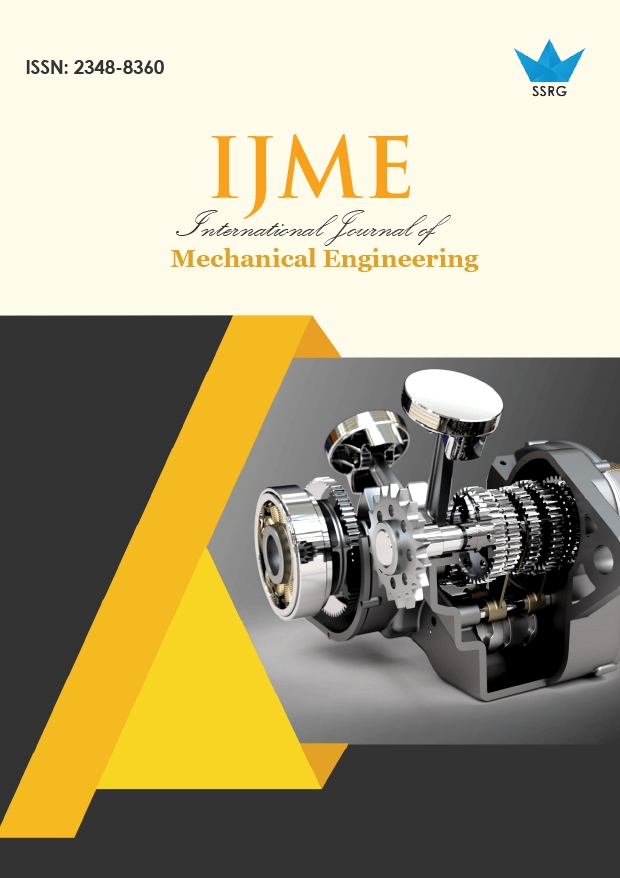Optimization of Tensile Response of Wood Ash Particles Reinforced Polypropylene (WARPP) for Auto Part Design

| International Journal of Mechanical Engineering |
| © 2015 by SSRG - IJME Journal |
| Volume 2 Issue 9 |
| Year of Publication : 2015 |
| Authors : Chukwutoo C. Ihueze, Patrick S. Aguh |
How to Cite?
Chukwutoo C. Ihueze, Patrick S. Aguh, "Optimization of Tensile Response of Wood Ash Particles Reinforced Polypropylene (WARPP) for Auto Part Design," SSRG International Journal of Mechanical Engineering, vol. 2, no. 9, pp. 10-21, 2015. Crossref, https://doi.org/10.14445/23488360/IJME-V2I9P103
Abstract:
The study focused on the use of response surface methodology to predict the optimal tensile response of wood ash particles /polypropylene combination for auto part (car bumper) design. Taguchi plan of experiment based on L9(3)4 was used to design the experiment. The data obtained from the experiment were analyzed using S/N ratio and mean of means as the statistical measure of performance. The response surface and contour plots show the optimized responses of individual interactions in the range of > 13.50MPa - > 19.50MPa. The contour and surface plots depict the behaviour of the tensile strength as two input variables vary and two held constant at their highest settings). The tensile strength of WARPP is in the range of 17.08MPa - 21.19MPa. The highest tensile strength value was obtained by simultaneous optimization of input variables depicted in optimization plot of figure 15 as 21.19MPa. Further investigations are recommendable for testing WARPP under high temperature for the design/formulation of auto part (car bumper) to ascertain its performance at elevated temperature.
Keywords:
Optimization, Experimental design, Taguchi method, Performance characteristics, Box- Behnken design, Interaction plots, TRD-RSM.
References:
[1] Amstead B.H., Ostwald P.F. and Begeman M.L. (1979), Manufacturing Processes; John Wiley and Sons Inc. p 256.
[2] Avallone E.A., Baumeister T. III (1997), Marks Standard Handbook for Mechanical Engineers, 10th Edition, McGraw Hill book company, Singapore, p 6-202.
[3] Bertoline G. R., Wiebe E. N., Miller C. I.,Mohler J. I.(1997). Technical Graphics Communication. McGraw Hill Company pp 948 – 949.
[4] Goodman M. M. (1998). The effects of Wood Ash Additive on the Structural Properties of Lime plaster.http//archive.org/stream/effectsofwoodashoogood/effects of woodash.
[5] Naik T. R., Kraus R., and Kumar R.(2001), Wood Ash: A New Source of Pozzolanic Material. Report No. CBU 2001 Center for Byproduct Utilization. University of Wisconsin.
[6] Okunade E. A., (2008), The effect of Wood Ash and Sawdust Admixture on the Engineering Properties of a Burnt Laterite Clay. Journal of Applied Sciences, 8: 1042 – 1048.
[7] Prahakaran K., Chinnarasu M., Senthil K., (2012) ‘for Design and Fabrication of Composite Bumper Light Passenger Vehicle’. International Journal of Modern Engineering Research Vol. 2 issue 4 pp 2552 -2556.
[8] Radharamanan R. and Ansui A. P. (2001), ‘Quality improvement of a production process using Taguchi methods’,Proceedings of Institute of Industrial Engineers Annual Conference, Dallas,Texas, 20 – 22.
[9] Vaidya A.A. (1988), Production of Synthetic Fibers Prentice- Hall of India Private Ltd, New Delhi.

 10.14445/23488360/IJME-V2I9P103
10.14445/23488360/IJME-V2I9P103